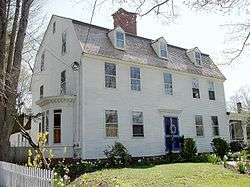Hayward House (Colchester, Connecticut)
The Hayward House is a historic house at 9 Hayward Avenue in Colchester, Connecticut. Built in 1775 and embellished in the late 19th century, it is a well-preserved 18th-century house, which has seen a number of locally prominent residents, as well as the nationally known inventor Nathaniel Hayward, who developed the process of vulcanizing rubber.[2] The house was listed on the National Register of Historic Places in 1972.[1]
Hayward House | |
 Hayward House in 2006 | |
  | |
| Location | 9 Hayward Ave., Colchester, Connecticut |
|---|---|
| Coordinates | 41°34′29″N 72°19′53″W |
| Area | 1 acre (0.40 ha) |
| Built | 1775 |
| Architect | Otis, Amos |
| Architectural style | Georgian |
| Part of | Colchester Village Historic District (ID94000254) |
| NRHP reference No. | 72001325[1] |
| Significant dates | |
| Added to NRHP | October 18, 1972 |
| Designated CP | April 4, 1994 |
Description and history
The Hayward House is located on the north side of Colchester's central village green, on the north side of Hayward Avenue. It is a three-story wood frame structure, with a gambrel roof, a large central chimney, and a single-story porch extending across the front. The roof is pierced by three gabled dormers. The main facade is five bays wide, with a center entrance framed by pilasters and a corniced entablature. A series of ells extend to the rear. On the left side a single-story polygonal bay projects, and a single-story screened porch extends across the right. During the late 19th-century, a Victorian porch was built across the front;[2] this has since been removed.
The house was built about 1775, by Abel Amos, a local builder, for Dudley Wright. At the time of its construction, it was one of largest and most elegant homes in the village. Wright operated a tavern on the premises, and also hosted meetings of the local Masonic lodge, which were held in a large ballroom that extends across the rear of the second floor. Dudley Wright's daughter married Doctor John Watrous, a figure locally prominent not just as a physician, but also for his civic involvement and philanthropy. In 1842, the house was purchased by the 19th-century inventor Nathaniel Hayward, the founder and principal owner of the Hayward Rubber Company.[2]
References
- "National Register Information System". National Register of Historic Places. National Park Service. March 13, 2009.
- Babbitt, Susan (April 19, 1972). "National Register of Historic Places Inventory-Nomination: Hayward House / Dudley Wright-Dr. Watrous-Nathaniel Hayward House". National Park Service. and Accompanying four photos, exterior, from 1972
External links
| Wikimedia Commons has media related to Hayward House. |
- Historic American Buildings Survey (HABS) No. CT-144, "Hayward House on Green, Colchester, New London County, CT", 1 photo